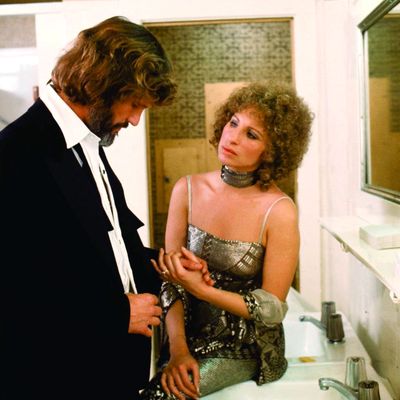
Much has been made of the fact that the actors in Les Misérables actually sang on-camera, as they were being filmed, instead of lip-synching to prerecorded tracks. (Remember this lengthy featurette, which seemingly aired before every movie released last fall?) Indeed, some of the movie’s press would have you believe that this is the first time this has ever been attempted in a musical film. To which we say: Untrue! Not only have other movies attempted this, but it was actually the norm in the early sound era. Here are five other musicals that used live singing, from the early days of Hollywood right through to the seventies.
The Rose (1979)
Look, you’ve got a great singer and actress like Bette Midler (back before she started making lame comedies) playing a character based on Janis Joplin: Why wouldn’t you have her sing live? Indeed, Midler’s performances of the songs in this film, including her occasional monologues, were included in the soundtrack album for the film, which became a massive hit and turned her into a star overnight.
A Star is Born (1976)
Barbra Streisand was not a fan of lip-syncing and insisted on recording the singing live during this remake of the 1937 classic, particularly during the all-important scene where her character and John Norman Howard (Kris Kristofferson) record “Evergreen,” which required the camera to come up close to them and would have drawn too much attention to the lip-syncing. Kristofferson, however, was afraid to record live and reportedly had to be talked into it. One wonders how Streisand’s earlier choices to play the part, Elvis Presley and the notoriously forgetful Marlon Brando, would have fared with the process.
At Long Last Love (1975)
Peter Bogdanovich’s attempt at a nostalgic musical featuring Cybill Shepherd and Burt Reynolds actually utilized a technology very similar to Les Miz: The melodies were played by a piano on set and transmitted to the actors via a hidden earpiece so they could keep rhythm as they sang. (The full orchestra would be recorded later.) The same frequency also carried instructions by Bogdanovich to the actors. Hilariously, this caused some problems, as in order to do all of this the production had to use an unauthorized radio frequency. Soon enough, government agents picked up the transmissions, heard the director’s cryptic instructions, traced the broadcast, and proceeded to raid the set, taking Bogdanovich and company into custody. Once it was released, the film itself proved to be a bust of a different sort.
The Love Parade (1929)
The great Ernst Lubitsch’s first sound film was one of Hollywood’s first true musicals as well as a huge hit. It was also a film of astounding technical ambition. At the time, musical numbers were usually recorded with a fixed camera shooting the actors as they sang, with an orchestra somewhere off-camera. But for one number, Lubitsch wanted to cut back and forth between two different couples singing the same song in two different locations. So, he had two sets built, placed the orchestra between them (off-camera), and then directed them simultaneously, with two different camera crews.
The Cocoanuts (1929)
Another early musical, this Marx Brothers–Irving Berlin collaboration was also one of the first examples of a Broadway musical that was adapted for the screen. But the film was shot in Astoria, New York, and reportedly had to deal with the problem of street noise, as soundproofing of film sets hadn’t become a thing yet. The solution was to shoot in the early morning hours. (They also reportedly had a hard time trying to figure out where to place the orchestra, which was an accepted standby at the time in stage musicals.) Another interesting factoid: All of the paper on-screen had to be soaked in water so as not to make too much crackling noise on the soundtrack.


